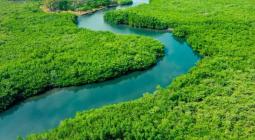The One Forest Summit was an important moment of mobilization by allowing a unity of time and place around a crucial issue, that of forests. The Climate Chance Association brought several messages about ecological connectivity and the need to provide African countries with endogenous financial resources. If the international commitments and the convergence of points of view seem to be taken into account, it is now urgent to direct these flows towards the populations by defining priorities for concerted action.
The One Forest Summit has undeniably allowed a significant mobilization around the central issue of forests by allowing a unity of time, place and concentration of actors who, otherwise, might not meet: policy makers, associations, the world of research, conservation experts, representatives of the private sector …
As an association that has been working since 2015 to bring together these actors, Climate Chance found its place and seized the opportunity to convey several messages on the climate-biodiversity-desertification convergence of the 3 Rio conventions, on ecological connectivity, on the need to provide African countries with stable and sustainable funding and to put local populations back at the heart of the conservation mechanisms.
The event also allowed us to be visible and to initiate a dialogue around partnerships and future collaborations for our projects. On the substance, the summit was, in our opinion and above all, a summit on carbon finance, the observation being that carbon credits stricto sensu are now a framework that is a little too weak, but that should not be totally swept away. It is possible and desirable to clean it up, strengthen it and give it credibility, for example, by measuring reliable impacts and measurable biodiversity co-benefits. Virtuous, well used and understood by African countries, it is a powerful tool to put at their service and that of local populations. The findings in the field are clear: climate change and biodiversity losses are closely linked and have had dramatic consequences for years: silting of rivers and water stress, deforestation and overexploitation of forest resources, desertification and loss of agricultural resources, acute problems of human-animal cohabitation, lack of funding, etc… while, ironically, the financial commitments of the various actors, all sectors combined, have perhaps never been so high!
On the ground, there are many struggles, but the solutions are often known, sometimes simple (and sometimes not…) and the actors (state and non-state) are available and truly motivated to implement them. So, how can we reconcile major international commitments and realities on the ground? How can we respond to the demands of local populations who experience climate change and biodiversity loss in their daily lives and who have, often in their communities, in their villages, solutions based on ancestral knowledge?
Events such as the One Forest Summit and others (for example, the year 2022 has seen 3 COPs) are obviously still useful to maintain dialogue and cooperation around major global issues, but there is an urgent need to define appropriate priorities by listening to the field, to redirect financial flows to the right place, to find reliable channels of redistribution and to strengthen the ownership of these new types of tools by African countries Climate Chance has been contributing to this process for several years by positioning itself as an aggregator whose main mission is to break down silos and create links and synergies in order to converge messages, projects and funding. Through its various actions (Global and African Climate Action Observatory, annual summits, coordination of international coalitions and demonstration projects), it is working towards the convergence of climate-biodiversity-desertification issues, weaving relationships and creating networks, which are sometimes long and complicated to achieve… but vital for our world.
By Anne Raimat
Biodiversity Director – Climate Chance







